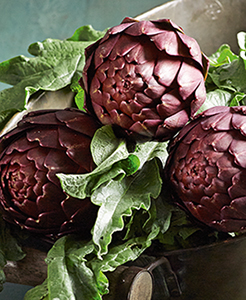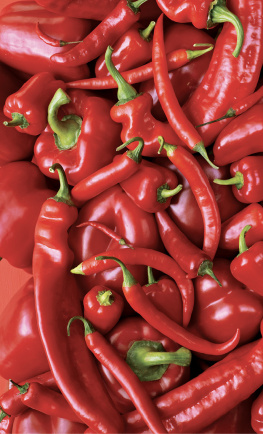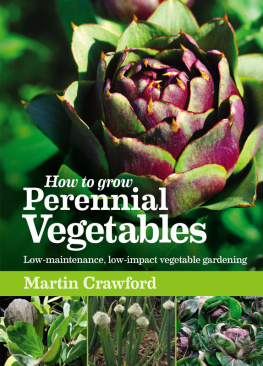Contents
There is nothing that is comparable to it, as satisfactory or as thrilling, as gathering the vegetables one has grown.
ALICE B. TOKLAS
AZ OF VEGETABLES
Vegetable directory
Artichokes
Both are called artichokes, but globe artichokes and Jerusalem artichokes are two very distinct plants. Globe artichokes grow like a giant Scotch thistle, and it is the unopened flower buds that are harvested. Jerusalem artichokes are tall-growing perennials in the sunflower family, and their roots are eaten.

The unopened flower buds of globe artichokes (top) and the knobby roots of Jerusalem artichokes (bottom) are the edible parts.

The attractive unopened flower buds of Violetta globe artichoke.
Globe artichoke
Cynara scolymus
This classic antipasto vegetable has a distinctive, delicate flavor. Its striking silver foliage appears in winter, and in late spring it produces edible flower buds that, if you fail to harvest them in time, open as stunning purple thistle-like flowers.
The buds, or heads, are harvested in spring, before they start to open and when the stem is still flexible. The stiff outer scales are compressed around a shallow base, called the heart, which is the most desirable edible part. A thick cluster of silky hairsthe chokeis embedded in the heart. The choke must be removed, either before or after cooking, and the stiff outer scales removed before cooking. They are eaten freshly cooked or preserved in oil. The stem can be peeled and cooked, too.
Growing
Globe artichokes are hardy and drought-tolerant once established, but will produce more buds when grown in rich soil and watered well. Plant young plants or suckers in full sun in well-drained soil during spring. The plants will flower for two to three months. To keep the plants productive, divide clumps every three to four years in winter, when dormant.
Harvesting A plant will yield up to 20 buds. Pick the largest bud, or king head, first. Use pruning shears or a sharp knife; leave on a 12.5-cm (5-in) stem.
Varieties
There are a number of green budded varieties that grow to around 1.5 m (5 ft) high. Violetta has highly ornamental dusky purplecolored buds and only grows to 1.2 m (4 ft) high.
Buying and storing
Look for tightly closed heads with plump leaves, or scales, that dont look dried or withered. Though best eaten the day they are purchased, they keep in a loosely sealed plastic bag in the crisper section of the refrigerator for up to four days.
Jerusalem artichoke
Helianthus tuberosus
Also known as sunchoke
This hardy plant is grown for the edible knobby tubers of its root system. It has an interesting nutty flavor and can be eaten raw, boiled, roasted, stir-fried, or in soups. It is renowned for its ability to cause flatulence, although this unwanted side effect can be reduced by serving it with fennel. The flowers last well when picked for a vase.

The Jerusalem artichoke is a low-starch tuber. When roasted, it has a mildly sweet, smoky flavor reminiscent of a potato, artichoke, and water chestnut all rolled into one.
Growing
This perennial is easy to grow and reaches up to 3 m (10 ft) high. It flowers in autumn with beautiful sunflower-like golden yellow flowers. These prolific flowers and its height make Jerusalem artichoke a good windbreak plant around tender vegetables.
Bare-rooted tubers are planted in winter in a sunny, well-drained position in reasonably fertile soil. It is often regarded as a permanent vegetable because any tubers left in the ground will reshoot. Be sure to dig up even the smallest tubers to prevent any unwanted regrowth in your garden.
Harvesting Dig up the tubers after the plants have died down in autumn. Handle with care, as the skins are thin. Brush off the soil and store in a dark, dry place. As with potatoes, it is important that you dont eat Jerusalem artichokes that have a greenish tinge.
Buying and storing
Choose firm Jerusalem artichokes with unwrinkled skins. Keep in a loosely sealed plastic bag in the crisper section of the refrigerator or in a very cool, dark place for up to a week.
Health benefits
A globe artichokes health benefit is found in the plants leaves: Research has shown that artichoke-leaf extract stimulates the gallbladder to release more fat-digesting bile acids. By boosting this cholesterol-rich bile, which is excreted from the body, it may help to reduce heart-threatening LDL cholesterol.
Jerusalem artichokes can cause gas, because they contain a hard-to-digest carbohydrate called inulin. Ironically, this substance has a beneficial effect on the gut: Inulin is a prebiotic that supports friendly bacteria such as Lactobacillus and Bifidobacterium , known to help protect against gastrointestinal disorders. Jerusalem artichokes are high in iron and also have a low GI, making them suitable for diabetics.
Globe artichokes are generally pest-free, apart from slugs, snails, and aphids. Slugs, nematodes, caterpillars, and two-spotted mites can do minor damage to Jerusalem artichokes.

Artichokes with lemon butter for dipping
The edible part of a globe artichoke is the unopened flower bud, which has a slightly sweet taste. Each artichoke is composed of fleshy gold-green to purple leaves (scales, or bracts) surrounding a hairy, inedible choke on top of an edible, tender heart.

Remove tough outer leaves from 4 globe artichokes. Trim the stem so the artichoke sits flat. Rub with a squeeze of lemon juice. Bring a large saucepan of lightly salted water to a boil. Add artichokes and simmer for 1520 minutes, until just tenderwhen a leaf from the middle pulls away easily and the heart is tender when pierced. Drain upside down.
Meanwhile, melt 125 g (4 oz) butter in a small saucepan and saut 1 crushed garlic clove. Add the juice of 1/2 lemon, season with salt and freshly ground black pepper, and stir to combine.
Pour the lemon butter into a serving bowl and serve alongside the artichokes. Eat 1 leaf at a time (scraping the flesh off the leaves with your teeth), discarding the choke, and then eating the heart.




















